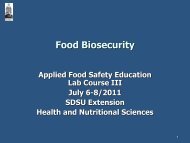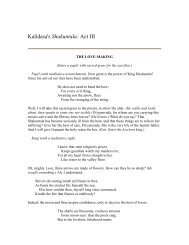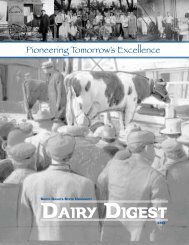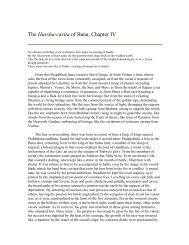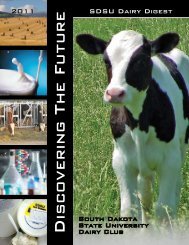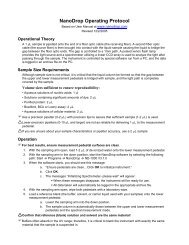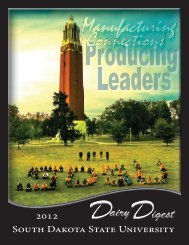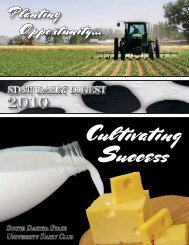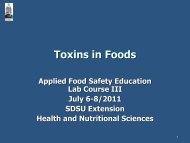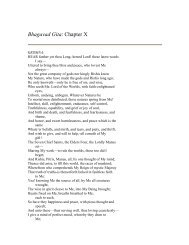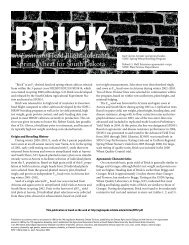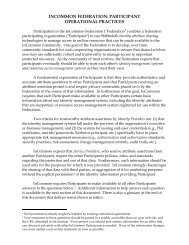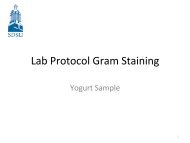2025 Design & Master Plan - South Dakota State University
2025 Design & Master Plan - South Dakota State University
2025 Design & Master Plan - South Dakota State University
You also want an ePaper? Increase the reach of your titles
YUMPU automatically turns print PDFs into web optimized ePapers that Google loves.
methodology of parking calculations<br />
The methodology within the supply-and-demand analysis took into account<br />
the multiple options employees have when purchasing a parking permit, and<br />
determined a percentage for lot assignments for full-time faculty and staff<br />
based on an examination of sales in previous years. Based on that data, it was<br />
determined that 50 percent of full-time faculty parking on campus should be<br />
alloted in reserved lots, 40 percent in commuter and 10 percent in remote. The<br />
breakdown also assumes a parking turnover rate of 1.0 for reserved and remote<br />
spots and .67 for commuter spaces.<br />
Part-time faculty and staff were accounted for with 10 percent in reserved<br />
parking at a turnover rate of 1.0 and 90 percent in commuter lots with a .67<br />
turnover rate.<br />
Student commuters drive to and from campus at more irregular hours, with most<br />
needing parking for only a portion of the day. The parking analysis examined<br />
three scenarios to determine a parking multiplier for student commuters of .26,<br />
meaning that student commuter parking turns over nearly four times per day.<br />
On-campus residential life demand was determined through surveys of<br />
residence hall occupants that showed approximately 88 percent of the<br />
students required to live on campus as freshmen and sophomores can be<br />
expected to bring a vehicle to campus. For planning purposes, a multiplier<br />
of .9 was adopted for residential life parking demands in the freshmen/<br />
sophomore market segments and a 1.0 multiplier for upper-division students<br />
living in residential facilities and requiring on-campus parking.<br />
NOTE: Current projections for student enrollment are through 2013 per<br />
the Updated Residential Life and Dining Services <strong>Master</strong> <strong>Plan</strong>. Future<br />
enrollment projections are being done through the <strong>University</strong>’s strategic<br />
planning process that will be implemented on July 1, 2013. Some flattening<br />
of enrollment on the Brookings campus is expected; therefore the parking<br />
supply and demand for future years is expected to maintain equilibrium and<br />
certainly is in line with the anticipated 11,754 Brookings campus students<br />
that are expected in 2013.<br />
Table 2.1: Parking Classifications, Total Spaces and Customer Benefits (Fall 2011)<br />
Parking Classification Total Spaces Customer Option Value<br />
Reserved 915 Faculty & Staff, Student Commuters Proximity to workplace, guaranteed parking space in designated lot<br />
Commuter 2,109 Faculty & Staff, Student Commuters Proximity to workplace, majority of lots located within campus core<br />
Residential Life (SE) 3,248 Student Residents<br />
Proximity to Residential Life facilities in southeast corner, family student housing,<br />
guaranteed parking space in designated lot<br />
Residential Life (NW) 941 Student Residents<br />
Proximity to Residential Life facilities in northwest corner, guaranteed parking<br />
space in designated lot<br />
Remote 633 Faculty & Staff, Student Commuters Less expensive price option, parking located outside of campus core<br />
Gravel Lot 388 Faculty & Staff, Student Commuters Free parking with $5 vehicle registration fee, parking located outside campus core<br />
Total 8,234<br />
Handicapped 219 Permit Required Accessible spaces; calculated in addition to total campus parking supply<br />
Hourly Parking at<br />
Student Union<br />
143 Pay Lot Calculated in addition to total campus parking supply<br />
Visitor Parking 81 Permit Required Various locations around campus; calculated in addition to total campus parking supply<br />
Table 2.2: Campus Parking Supply / Demand (Fall 2011)<br />
Customer Demand Reserved Commuter Residential Life (SE) Residential Life (NW) Remote and Gravel Total<br />
Faculty & Staff 838 578 0 0 163 1,579<br />
Student Commuters 0 1,482 0 0 0 1,482<br />
Residents (SE) 0 0 2,743 0 0 2,743<br />
Residents (NW) 0 0 0 901 0 901<br />
Total Demand 838 2,060 2,743 901 163 6,705<br />
Total Supply 915 2,109 3,248 941 1,021 8,234<br />
• Parking demand and turnover rate calculations are described in the above “Methodology of Parking Calculations.”<br />
• Demand accounts for all employees and student commuters driving to and parking on campus.<br />
• Demand accounts for all faculty being on-campus five days a week.<br />
14



